Stay connected
Subscribe to our fleet blog and follow us on social media to receive all our fuel and energy industry insights.

As of Q3 2024, the United States had nearly 192,000 public electric vehicle (EV) charging ports making it easier and more accessible for American businesses to add electric vehicles to their fleets. EVs are no longer the futuristic concept they once were; they are here, they are growing in popularity, and they are reshaping industries. According to a recent report by the International Energy Agency (IEA), EV sales surpassed 10 million globally in 2023, marking a 55% increase from the previous year. With innovations accelerating and governments worldwide pushing for greener initiatives, EVs are steadily becoming a cornerstone of the transportation sector.
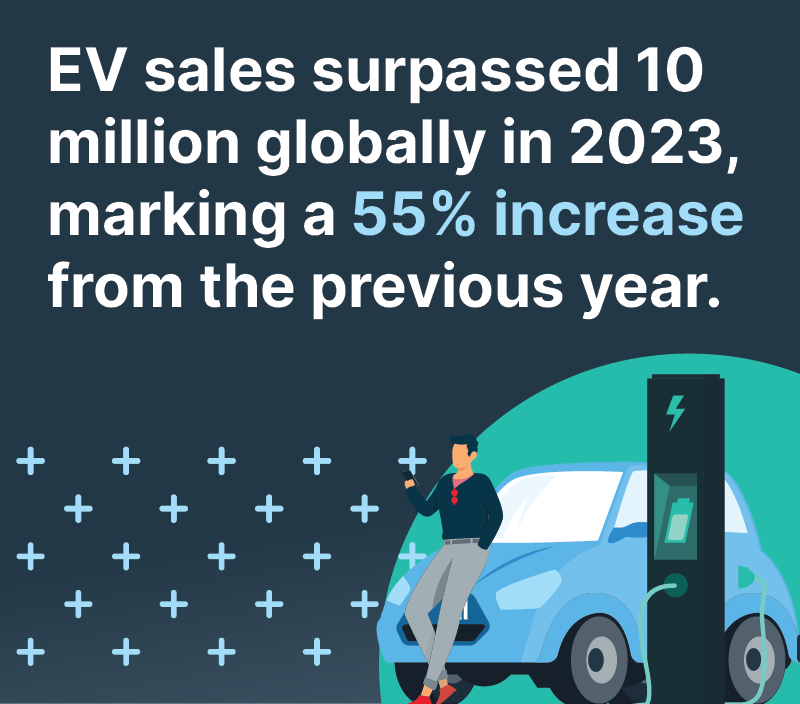
But what does this mean for individuals and businesses navigating the transition from traditional vehicles to electric ones? For many of us, EVs might conjure images of sleek cars quietly gliding down the road, but the truth is far more intricate. Electric vehicles come in a wide array of designs, capabilities, and price points, and their integration involves careful planning and adaptation.
The challenge lies in the complexity of understanding and adopting this technology: from deciphering battery capacities and charging speeds to weighing environmental benefits against logistical challenges. As highlighted in a McKinsey & Company report, successful adoption requires a strategic approach to address both practical and financial considerations.
The question becomes: how do you choose the right EV for your business needs and adapt your operations to make the most of this transformative technology?
In this article, we dive into everything you need to know to make informed decisions about EVs—from their evolution and benefits to the hurdles of adoption and the roadmap for transitioning seamlessly – whether you’re considering an EV for personal use, exploring options for your business, or looking to future-proof your fleet.
Electric vehicles (EVs) have a rich history that predates the internal combustion engine, dating back to the early 19th century. While today’s EVs are associated with sleek designs and cutting-edge technology, their origins are rooted in innovation driven by necessity and curiosity. As reported by the U.S. Department of Energy (DOE), the first small-scale EVs appeared as early as the 1830s, powered by rudimentary batteries and limited to short distances.
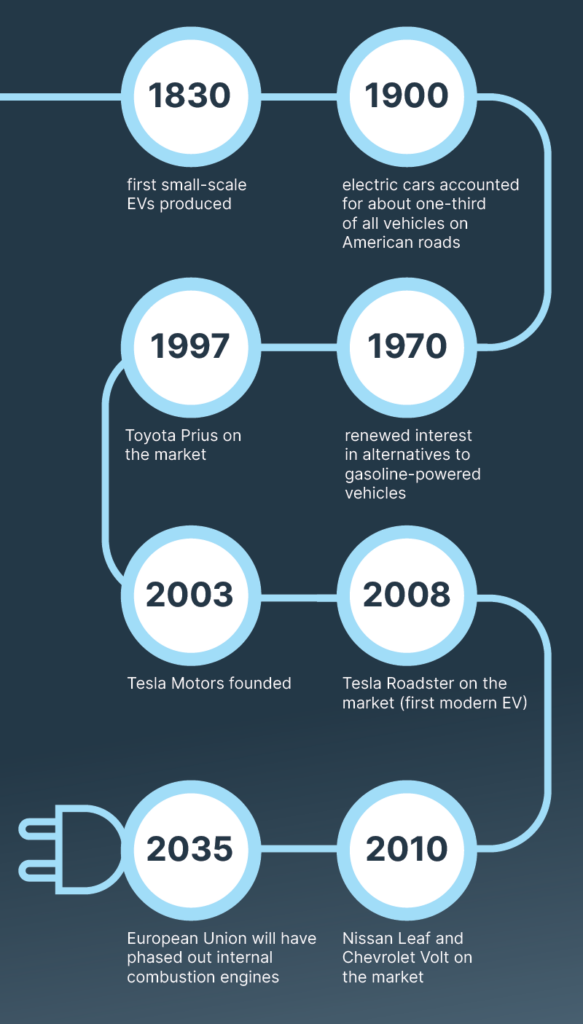
Fast forward to the late 19th and early 20th centuries, EVs emerged as a popular choice for personal transportation. They offered a quieter and cleaner alternative to the noisy, smoke-belching gasoline cars of the era. In fact, by 1900, electric cars accounted for about one-third of all vehicles on American roads (Smithsonian Institution). But, as gas-powered cars became more affordable due to Henry Ford’s assembly line production, EVs lost their foothold in the market.
The mid-20th century marked a period of dormancy for EVs, as fossil fuels dominated the transportation sector. However, the energy crises of the 1970s sparked a renewed interest in alternatives to gasoline-powered vehicles. As highlighted by a 2023 BloombergNEF report, early efforts to revive EVs were hindered by technological limitations, including inefficient batteries and high production costs.
The true renaissance of EVs began in the early 2000s, spurred by growing environmental concerns and significant advancements in lithium-ion battery technology. Tesla Motors, founded in 2003, is often credited with bringing EVs into the mainstream by combining extended range with luxury appeal. Other automakers, such as Nissan and Chevrolet, soon followed with models like the Nissan Leaf and Chevrolet Volt, targeting a broader consumer base.
Today, EVs are no longer niche products but are critical to global transportation strategies. Government initiatives, such as the European Union’s plan to phase out internal combustion engines by 2035, have accelerated the transition to electric mobility. Additionally, countries like China and India are leading EV adoption in developing markets, supported by aggressive infrastructure investments and subsidies.
As we stand on the cusp of widespread EV adoption, the evolution of electric vehicles is a testament to how technology, market forces, and environmental priorities can intersect to shape the future of mobility.
There are three different types of EVs currently on the road:
EVs operate on a fundamentally different principle than internal combustion engine (ICE) vehicles. Instead of relying on fossil fuels, EVs use electricity stored in batteries to power an electric motor. This innovative design not only eliminates tailpipe emissions but also simplifies the overall mechanics of the vehicle. As noted by the U.S. Department of Energy (DOE), EVs have far fewer moving parts than their ICE counterparts, leading to improved efficiency and lower maintenance costs.
Within the bones of every EV is the battery pack, typically made up of lithium-ion cells similar to those found in smartphones or laptops. These batteries store the energy required to power the vehicle and are engineered for durability and energy density. Charging the battery involves transferring electricity from an external power source into the vehicle. There are three main types of chargers:
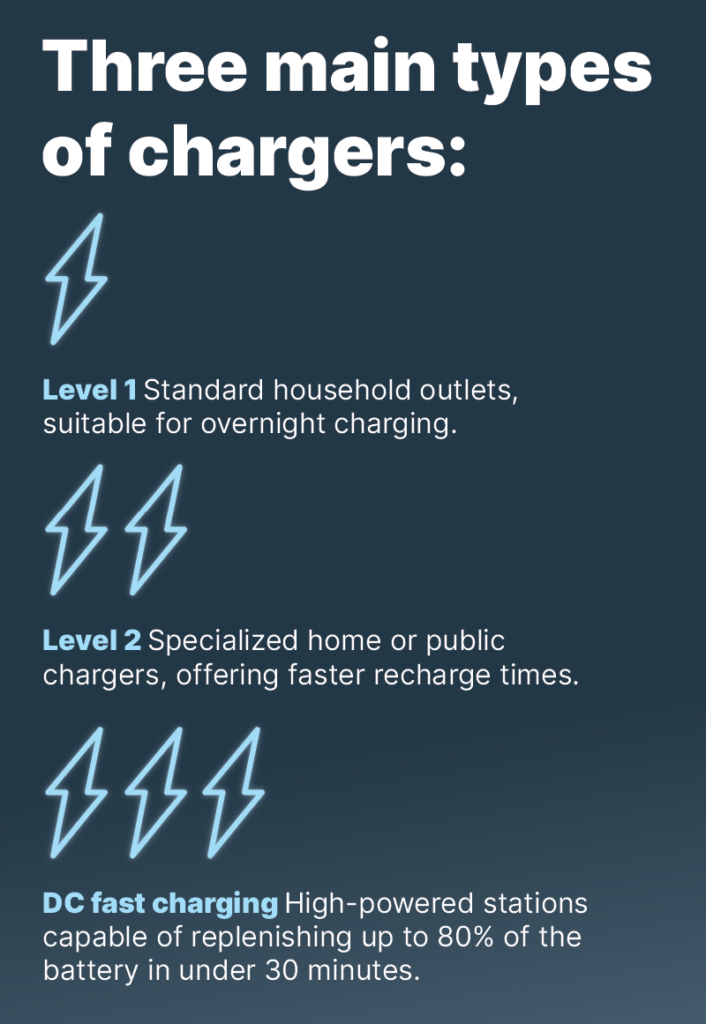
The energy from the battery powers the electric motor, which converts electrical energy into mechanical energy to drive the wheels. Unlike ICE vehicles, which require a complex system of transmissions and fuel combustion, electric motors deliver instant torque, allowing EVs to accelerate smoothly and quickly. This is one of the reasons EVs are known for their exceptional performance on the road.
EVs also incorporate regenerative braking, a feature that captures energy typically lost during braking and redirects it back into the battery. This process increases the vehicle’s range and enhances energy efficiency. According to a McKinsey & Company report, regenerative braking can improve overall energy usage by up to 30%, depending on driving conditions.
Another critical component of EVs is their onboard control systems, which manage energy flow and ensure optimal performance. These systems monitor battery health, control power distribution, and provide real-time feedback to drivers about energy consumption and range. Some advanced EVs even use artificial intelligence to optimize routes and energy use, as highlighted in a recent BloombergNEF study.
Charging infrastructure is an essential part of the EV ecosystem. While home charging remains the most convenient option for many, the growth of public charging networks has made EVs more practical for longer trips. Countries like the U.S., China, and members of the European Union are rapidly expanding fast-charging networks, supported by government incentives and private investment.
From their energy-dense batteries to their efficient electric motors and advanced control systems, EVs represent a leap forward in automotive technology. Their design not only simplifies vehicle mechanics but also opens the door to a more sustainable and efficient future for transportation.
The shift toward electric vehicles is transforming how we travel and redefining sustainability and cost-efficiency in transportation. From environmental advantages to long-term savings, EVs offer a compelling case for individuals and businesses alike.
One of the most significant benefits of EVs is their potential to reduce greenhouse gas emissions. Unlike internal combustion engine vehicles, EVs produce zero tailpipe emissions, which is critical in the fight against climate change.
When assessing the environmental impact of vehicles, it’s important to understand the distinction between lifecycle emissions and tailpipe emissions. Both metrics are used to evaluate the carbon footprint of vehicles, but they measure emissions at different stages of a vehicle’s use and production.
According to the International Energy Agency (IEA), a typical EV produces less than half the lifecycle emissions of a comparable gasoline vehicle when charged from an average global energy grid. In regions where renewable energy sources dominate, these emissions are even lower. Additionally, EVs contribute to cleaner air, reduced smog, and improved public health, particularly in urban areas.
EVs are not just environmentally friendly—they can also be financially advantageous over time. While the upfront cost of an EV may be higher than that of a comparable ICE vehicle, owners can benefit from significantly lower operating expenses. A report from the U.S. Department of Energy (DOE) highlights that typically EVs cost $800-$1,000 less to power annually than gasoline-powered vehicles, depending on electricity rates. Maintenance costs are also typically reduced, as EVs have fewer moving parts, eliminating the need for oil changes, exhaust system repairs, and other ICE-specific services.
EVs are inherently more energy-efficient than ICE vehicles, converting up to 77% of the electrical energy from the grid to power the wheels, compared to the roughly 20% efficiency of gasoline engines (U.S. Department of Energy). This efficiency translates to longer distances traveled per unit of energy, making EVs a more sustainable choice for daily commutes and long trips alike.
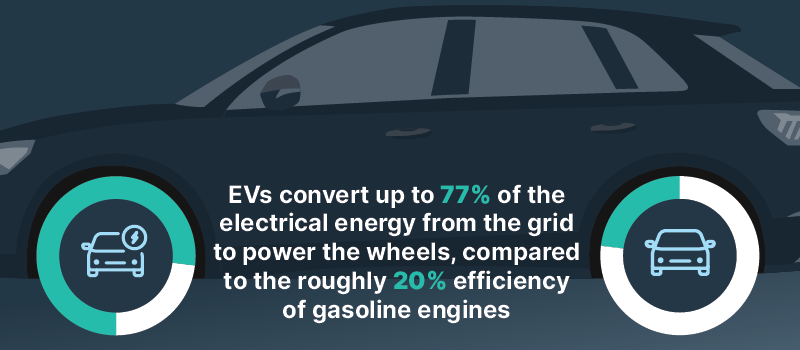
To encourage EV adoption, many governments offer financial incentives, including tax credits, rebates, and grants. For instance, the U.S. Federal EV Tax Credit provides up to $7,500 for qualifying vehicles (U.S. Internal Revenue Service). Additionally, some states and municipalities offer further incentives, such as reduced registration fees, toll exemptions, and free parking. These policies make EVs more accessible and appealing to a broader audience.
EVs are known for their smooth, quiet operation and outstanding driving experience. Thanks to their electric motors, EVs deliver instant torque, enabling quick acceleration without the lag of traditional transmissions. Additionally, the low center of gravity provided by the battery placement improves handling and stability, especially in sharp turns or challenging road conditions.
Switching to EVs promotes energy security by reducing dependence on imported oil. By relying on electricity, which can be generated domestically from renewable sources such as wind, solar, and hydropower, countries can mitigate the economic and geopolitical risks associated with oil dependency (IEA Global EV Outlook 2024).
EV technology supports the development of a circular economy, particularly through battery recycling and reuse. Companies like Redwood Materials are pioneering efforts to recover valuable materials like lithium, cobalt, and nickel from used batteries, reducing the need for mining and lowering the environmental impact of battery production (McKinsey & Company, Sustainability in EV Manufacturing).
In addition to reducing air pollution, EVs also combat noise pollution. Their nearly silent operation is particularly beneficial in densely populated urban areas, contributing to a quieter and more serene living environment.
The benefits of EVs extend far beyond the individual user, driving progress toward a more sustainable, cost-effective, and environmentally friendly transportation system. As adoption rates rise and technology continues to improve, these advantages will likely only grow more pronounced.
While electric vehicles represent a transformative step forward for transportation, their widespread adoption comes with challenges that individuals, businesses, and governments must address. From range anxiety to infrastructure gaps, these limitations highlight the hurdles in transitioning to an all-electric future.
One of the most commonly cited concerns with EVs is their limited range compared to ICE vehicles. While modern EVs can travel between 200–400 miles on a single charge, this can be insufficient for long-distance travelers or those in rural areas. According to a report by McKinsey & Company, range anxiety remains a significant barrier for consumers, despite advancements in battery technology.
Although EV charging networks are expanding, gaps in coverage still exist, especially in rural or underserved areas. The International Energy Agency (IEA) reports that public charging stations have grown significantly, but demand continues to outpace supply in many regions. Additionally, the variation in charger types—Level 1, Level 2, and DC fast chargers—can confuse new EV users. The lack of standardized connectors across all EV models adds another layer of complexity.
The upfront cost of purchasing an EV is typically higher than that of traditional vehicles, primarily due to the expense of lithium-ion batteries. While prices are declining—dropping by about 89% over the past decade according to BloombergNEF—EVs still remain out of reach for many budget-conscious consumers.
The production of EV batteries comes with environmental and ethical concerns. Mining for critical materials like lithium, cobalt, and nickel has been linked to habitat destruction, water depletion, and exploitative labor practices. A study by The World Bank warns that the growing demand for these minerals could lead to significant environmental challenges if sustainable mining practices are not implemented. Furthermore, the recycling infrastructure for EV batteries is still in its infancy, raising questions about how to manage end-of-life battery disposal.
Unlike ICE vehicles, which can be refueled in minutes, charging an EV can take significantly longer, even with fast chargers. Level 2 chargers typically require several hours to fully charge a vehicle, and Level 1 home charging can take even longer. While technologies like ultra-fast chargers are emerging, they remain expensive to install and are not yet widespread. This time factor can be a deterrent for drivers accustomed to the convenience of quick refueling.
The increased adoption of EVs places additional strain on existing electrical grids. A report by the U.S. Department of Energy (DOE) indicates that widespread EV usage could require significant upgrades to grid infrastructure, particularly in areas with high population density. Ensuring a reliable and renewable energy supply to power EVs is another critical challenge.
Extreme weather conditions, such as very cold or hot temperatures, can impact an EV’s battery performance and reduce its range. According to a study by the American Automobile Association (AAA), EVs can lose up to 41% of their range in subzero temperatures with heating systems in use. This makes EVs less practical for regions with harsh climates unless advancements in battery insulation and thermal management are achieved.
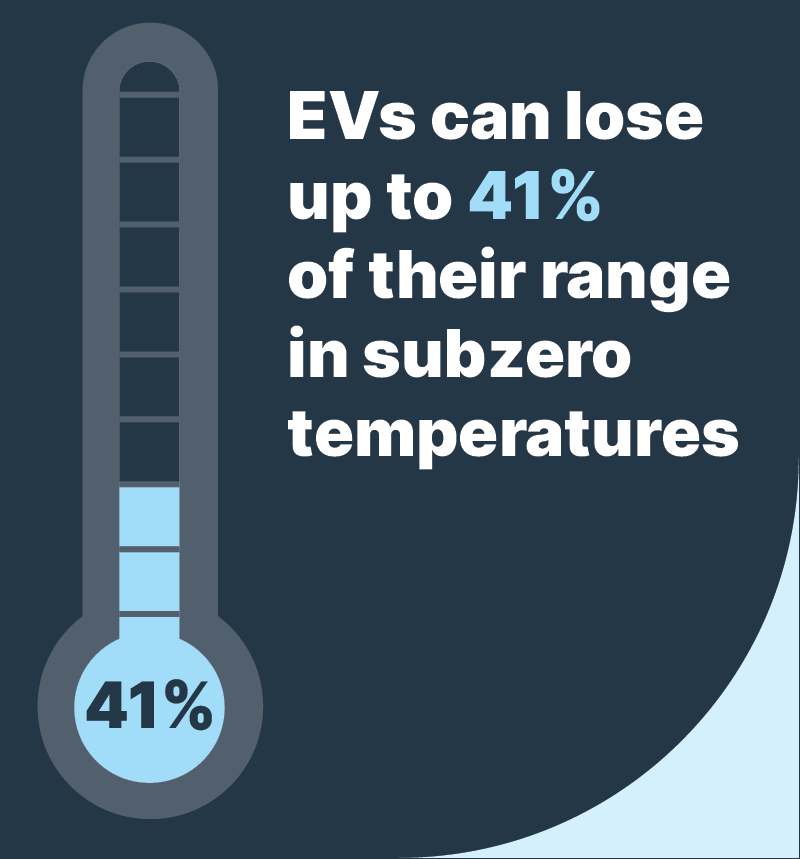
Adopting an EV often requires a shift in mindset and habits, such as planning for charging stops or understanding battery maintenance. Many potential buyers remain unaware of how EVs work, the incentives available, or the long-term benefits they offer. As highlighted in a survey by JD Power, a lack of education about EV ownership remains a significant barrier to adoption.
While the variety of EV models is increasing, certain segments, such as heavy-duty trucks or affordable compact cars, still have limited options. For businesses with specific fleet requirements, this lack of diversity in the EV market can be a deterrent.
The benefits of EVs are not equally distributed across all demographics. Rural and low-income communities often face greater challenges in accessing EVs and charging infrastructure. The World Economic Forum emphasizes that addressing these disparities is crucial to ensuring a just transition to sustainable mobility.
Despite these challenges, the EV industry continues to make strides in overcoming these barriers through technological innovation, policy support, and collaboration across stakeholders. Addressing these limitations will be critical to unlocking the full potential of EVs and driving their adoption on a global scale.
Electric vehicles are poised to reshape global transportation, driven by rapid technological advancements, ambitious government policies, and shifting consumer preferences. As adoption rates grow, the EV industry is moving toward greater efficiency, accessibility, and integration with renewable energy systems.
Battery innovation is at the heart of the EV revolution. Over the next decade, new technologies like solid-state batteries promise to significantly increase energy density, reduce charging times, and extend vehicle range. According to BloombergNEF, solid-state batteries (SSBs) could become commercially viable by 2030, with Tesla planning on incorporating them as early as this year. SSBs offer up to 50% greater energy density compared to today’s lithium-ion batteries. SSBs are batteries that use a solid electrolyte to move ions between electrodes, instead of a liquid or gel electrolyte. They have many potential advantages over lithium-ion batteries, including higher energy density, faster charging, and longer life. Furthermore, the development of cobalt-free and fully recyclable batteries will reduce environmental impact and address supply chain challenges.
The convergence of EV technology with autonomous driving is expected to redefine mobility. Self-driving electric cars and trucks have the potential to revolutionize logistics, public transportation, and personal travel. A report by McKinsey & Company predicts that by 2040, autonomous EVs could account for up to 40% of new vehicle sales globally. These vehicles will rely on advanced sensors, AI-powered navigation, and vehicle-to-everything (V2X) communication systems to optimize safety and efficiency.
As EV adoption grows, their potential as mobile energy storage units is becoming a game-changer. Vehicle-to-grid (V2G) technology allows EVs to send electricity back to the grid during peak demand, stabilizing energy supply. The International Energy Agency (IEA) highlights that widespread V2G adoption could save utilities billions in grid upgrade costs and provide EV owners with new revenue streams. Pilot programs in countries like Japan and the Netherlands are already demonstrating the feasibility of this technology.
The future of EVs depends heavily on the availability of reliable and efficient charging networks. Governments and private companies are investing heavily in expanding charging infrastructure. For example, the U.S. Department of Energy (DOE) has allocated $7.5 billion to build a nationwide network of 500,000 EV chargers by 2030. Innovations such as ultra-fast chargers, wireless charging, and solar-powered stations will further enhance convenience for EV users.
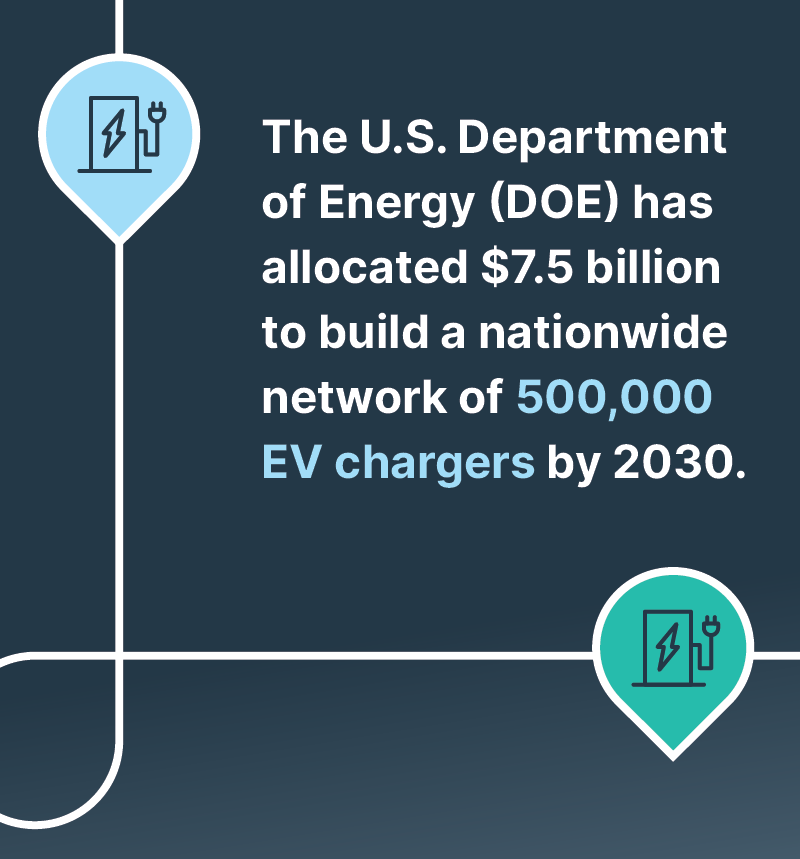
Many countries are enacting bold policies to accelerate the transition to EVs. The European Union plans to phase out internal combustion engine vehicle sales by 2035, while S&P Global shares that China aims for EVs to make up 50% of new car sales by 2030. In the U.S., federal and state governments are offering tax credits, rebates, and grants to make EVs more accessible to consumers and businesses. However, with a new administration in place this year in the U.S., it will be interesting to observe whether these EV adoption governmental supports are upheld.
While EV adoption has largely been concentrated in developed countries, emerging markets are expected to play more of a role in the future. According to the World Economic Forum, countries like India, Brazil, and Indonesia are investing in affordable EV models and localized manufacturing to meet the needs of their populations. These regions will also benefit from innovative financing models and partnerships to build charging infrastructure.
The commercial sector is increasingly embracing EVs as a cost-effective and sustainable solution for transportation. Major logistics companies like Amazon and FedEx are already transitioning to electric delivery vans and trucks, supported by manufacturers such as Rivian and Tesla. A Deloitte report estimates that 70% of commercial fleets in the U.S. will be electric by 2040.
The integration of EVs with renewable energy sources is key to achieving a truly sustainable future. Solar- and wind-powered charging stations, combined with smart grids, will ensure that EVs are powered by clean energy. A report by the International Renewable Energy Agency (IRENA) states that this synergy could reduce global transportation emissions by 70% by 2050.
The future of EVs will also depend on ongoing collaboration between automakers, governments, and technology companies. Initiatives like the Zero Emission Vehicle (ZEV) Alliance are fostering international partnerships to share best practices and accelerate innovation.
As EVs become more mainstream, they are expected to influence broader cultural shifts toward sustainability. The younger generation, in particular, is driving demand for eco-friendly and technologically advanced vehicles. Public awareness campaigns, educational programs, and community initiatives will likely only continue to further support the adoption of EVs and promote sustainable practices.
The future of EVs is bright, but it requires continued investment, innovation, and cooperation to overcome challenges and achieve a truly sustainable transportation ecosystem. With rapid advancements in technology and growing global support, EVs are set to transform the way we move, work, and live.
As businesses increasingly look to reduce operating costs and meet sustainability goals, electric vehicles are becoming an attractive option for commercial fleets. However, selecting the right EV for your business requires careful consideration of operational needs, financial implications, and long-term goals.
The first step in choosing an EV is evaluating your specific operational requirements. Part of that analysis will be which ICE vehicles it makes the most sense to replace with electric vehicles. Factors such as average daily mileage, payload capacity, and route type (urban, highway, or mixed) play a crucial role in determining the best EV for your business. According to a report by McKinsey & Company, businesses that carefully match vehicle capabilities to their operational needs see the greatest return on investment (ROI) from EV adoption.
The International Energy Agency (IEA) highlights that by 2030, nearly 50% of new commercial vehicle sales are expected to be electric, driven by advances in battery technology and falling costs. There is a growing variety of EV models designed for businesses, including:
While the upfront cost of an EV is typically higher than that of an internal combustion engine (ICE) vehicle, the lower operational costs can result in significant long-term savings. An Atlas Public Policy analysis shows that EVs can reduce maintenance costs on average 40% and fuel costs by between 40 and 65% depending on the model, making them a cost-effective choice for many businesses. Businesses should consider government incentives, tax credits, and grants that can offset purchase costs. For example, the U.S. federal EV tax credit offers up to $7,500 for eligible vehicles (U.S. Internal Revenue Service).
Charging infrastructure is a critical consideration for fleet electrification. Businesses must evaluate whether to install on-site charging stations or rely on public networks. For fleets operating in fixed areas, installing Level 2 chargers at company locations ensures reliability and reduces downtime. Alternatively, businesses with long-haul needs may need to invest in access to DC fast chargers. A report by BloombergNEF emphasizes that companies adopting EVs should plan their charging strategy early to optimize fleet efficiency.
Range anxiety can be a significant concern for businesses. When selecting an EV, consider the typical driving distance and ensure that the vehicle’s range comfortably exceeds these requirements. Additionally, pay attention to the vehicle’s performance in adverse conditions such as cold weather, which can reduce range by up to 30%, according to the American Automobile Association (AAA).
For businesses planning to expand their fleets, it’s essential to choose EVs that align with long-term scalability goals. Certain manufacturers are introducing modular EV platforms that can accommodate different configurations, making it easier for businesses to scale operations as technology evolves. The World Economic Forum notes that adopting scalable EV solutions is key to future-proofing investments.
For businesses committed to sustainability, transitioning to EVs aligns with corporate social responsibility (CSR) objectives. Beyond reducing greenhouse gas emissions, many EVs are manufactured with a focus on minimizing environmental impact. Companies can also leverage EV adoption as part of their marketing and branding strategy, demonstrating a commitment to environmental stewardship.
Businesses adopting EVs can optimize performance and reduce costs using fleet management software. These tools monitor battery health, track energy usage, and provide insights into driver behavior. Geotab, a leader in fleet telematics, reports that integrating EV data analytics can enhance operational efficiency by up to 20%. WEX and Geotab have been strategic partners since 2012.
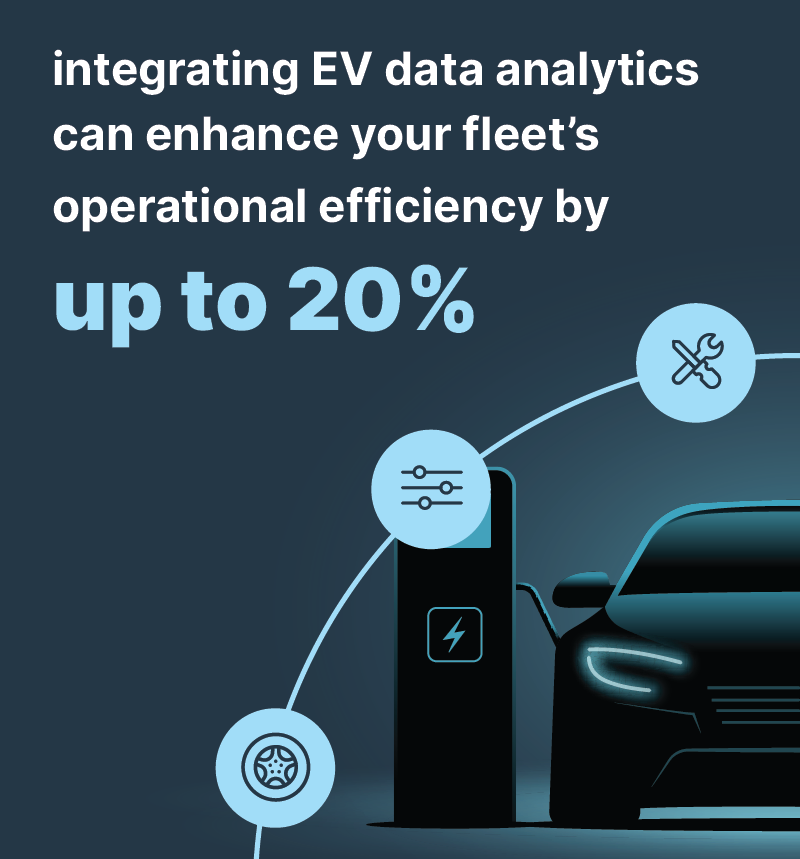
Selecting the right EV for your business involves more than just comparing vehicles—it requires a comprehensive strategy that considers cost, infrastructure, and long-term goals. By carefully evaluating these factors, businesses can make informed decisions that drive both financial and environmental benefits. Sawatch Labs**, a WEX company, offers cutting-edge fleet electrification analytics software to help businesses and government entities determine the best approach for EV adoption.
Transitioning to a mixed-energy fleet—combining EVs with traditional ICE vehicles—is a strategic move for businesses looking to balance sustainability with operational efficiency. However, the process requires careful planning to optimize costs, minimize disruption, and ensure a seamless integration of technologies. Here are key tips for successfully managing this transition.
Begin by evaluating your current fleet to identify which vehicles are best suited for electrification. According to McKinsey & Company, businesses should prioritize electrifying vehicles that operate in predictable, high-mileage routes, such as delivery vans or commuter vehicles. For long-haul or heavy-duty operations, ICE vehicles or hybrid solutions may remain necessary in the near term.
Instead of transitioning your entire fleet at once, adopt a phased approach. Start with a pilot program involving a subset of vehicles to test EV performance, charging infrastructure, and maintenance processes. A report by BloombergNEF highlights that businesses that phase their adoption can better manage costs and learn from early implementation challenges.
Investing in a charging infrastructure is crucial for a mixed-energy fleet. If you have electric vehicles that are domiciled at the workplace, consider installing Level 2 chargers at key operational hubs and prove drivers access to public DC fast chargers for flexibility. Additionally, software solutions like smart charging systems can help balance energy usage and minimize electricity costs by scheduling charging during off-peak hours (International Energy Agency).
Fleet management software is essential for monitoring both EVs and ICE vehicles. Tools like WEX Telematics combined with a WEX fleet card offer insights into fuel consumption, driving and charging patterns, and vehicle health, enabling fleet managers to optimize operations. By analyzing this data, businesses can identify areas for improvement and further electrification opportunities.
Educate drivers and staff on the differences between EVs and ICE vehicles, focusing on efficient driving techniques, charging procedures, and maintenance requirements. According to a study by JD Power, businesses that invest in driver training see higher satisfaction and fewer operational issues during the transition.
Track the TCO for EVs and ICE vehicles in your fleet to assess the financial benefits of electrification. While EVs have higher upfront costs, their lower fuel and maintenance expenses can lead to significant savings over time. A Deloitte analysis suggests that monitoring TCO regularly can help businesses determine when to accelerate electrification based on ROI.
Align your fleet strategy with your organization’s sustainability objectives. Transitioning to a mixed-energy fleet can reduce emissions and demonstrate your commitment to environmental responsibility. The World Economic Forum notes that businesses prioritizing sustainability are better positioned to meet regulatory requirements and enhance their brand image.
To overcome range anxiety and performance limitations, provide clear guidelines for drivers on optimizing battery life and planning routes. Additionally, consider hybrid options for vehicles operating in areas with limited charging infrastructure. The American Automobile Association (AAA) recommends using route-planning tools to ensure EVs meet operational demands without interruptions.
Leverage government incentives and partnerships with EV manufacturers to reduce transition costs. The U.S. Department of Energy (DOE) offers grants and rebates for businesses installing charging infrastructure or purchasing EVs (DOE Alternative Fuels Data Center). There is the possibility that under the new administration as of January 2025 this may change, but for now these grants and rebates are still in place. Partnering with charging providers can also secure favorable rates and access to expanded networks.
Design your mixed-energy fleet strategy with future expansion in mind. Invest in scalable charging infrastructure and evaluate emerging technologies, such as vehicle-to-grid (V2G) integration, to enhance efficiency and sustainability. According to IRENA, planning for scalability ensures that your fleet remains adaptable as EV technology evolves.
Transparency with employees, customers, and other stakeholders is critical during the transition. Share your goals, progress, and successes to build trust and gain buy-in. Highlighting the environmental and financial benefits of a mixed-energy fleet can also strengthen your organization’s reputation.
Transitioning to a mixed-energy fleet is a journey that requires strategic planning and collaboration. By addressing these key considerations, businesses can reap the benefits of electrification while maintaining the flexibility needed for diverse operational needs.
The transition to electric vehicles represents one of the most significant transformations in transportation history, with profound implications for individuals, businesses, and the planet. While EVs offer numerous benefits—ranging from reduced emissions and cost savings to cutting-edge technology—they also present challenges that require thoughtful planning and collaboration.
For individuals, the rise of EVs means a shift toward cleaner and more efficient personal transportation. With growing incentives, expanding infrastructure, and advancements in battery technology, adopting an EV has never been more accessible. As highlighted by the International Energy Agency (IEA), the global EV market is on track to surpass 50 million units by 2030, driven by supportive policies and consumer demand.
For businesses, electrification provides a possible pathway to achieving sustainability goals while reducing operating expenses. A mixed-energy fleet strategy allows organizations to balance efficiency with practicality, gradually transitioning to greener operations without sacrificing performance. According to BloombergNEF, businesses that adopt EVs now will not only lower costs but also gain a competitive advantage as regulations tighten and public demand for sustainable practices increases.
At a global level, by reducing reliance on fossil fuels and integrating with renewable energy systems, EVs can significantly lower transportation-related emissions. However, as noted by the World Economic Forum, realizing this vision will require continued investment in infrastructure, innovation in battery recycling, and policies that ensure equitable access to EVs.
As we look ahead, the key to a successful transition lies in education, collaboration, and strategic decision-making. By staying informed, leveraging available resources, and planning for the future, individuals and organizations can navigate this transformative era with confidence.
Consider these additional resources to help you understand the finer details, make smarter decisions, and navigate the EV landscape with ease.
Addressing common concerns and misconceptions is critical for individuals and businesses exploring EV adoption. Key questions include:
Here is a more comprehensive list of FAQs.
Utilize online tools to calculate the costs and benefits of EV ownership:
Real-world examples provide valuable insights into the challenges and rewards of adopting EVs:
Stay informed with reputable sources and organizations dedicated to advancing EV knowledge:
Keep an eye on emerging technologies and trends shaping the future of EVs:
By exploring these additional elements, you can better understand the opportunities and challenges associated with EVs. From practical tools to cutting-edge innovations, these resources provide a well-rounded perspective to help you navigate the electrified future of transportation.
All fleet cards are not the same, and different types of fuel cards suit the needs of different kinds and sizes of businesses. View WEX’s fleet card comparison chart to see which fleet fuel card is right for you.
WEX speaks the language of small business operators. Whether you’re looking to modernize your insight and reporting efforts, save on fuel costs or take advantage of the latest GPS tracking technologies, WEX offers solutions to simplify the business of running a business. To learn more about WEX, a dynamic and nimble global organization, please visit our About WEX page.
To learn more about EV solutions and mixed fleets, visit:
Resources:
EVgo
International Energy Agency (IEA)
McKinsey & Company
U.S. Department of Energy (DOE)
Smithsonian Institution
BloombergNEF
U.S. Internal Revenue Service (IRS)
The World Bank
American Automobile Association (AAA)
JD Power
World Economic Forum
S&P Global
European Commission
Deloitte
International Renewable Energy Agency (IRENA)
Zero Emission Vehicle (ZEV) Alliance
Geotab
National Highway Traffic Safety Administration, EV Safety Standards
Internal Revenue Service (IRS), EV Tax Credit Guidelines
Encyclopedia Britannica
Yahoo Finance
*ChargePoint and WEX have an EV charging partnership.
**Sawatch Labs is now a WEX company.
Subscribe to our fleet blog and follow us on social media to receive all our fuel and energy industry insights.